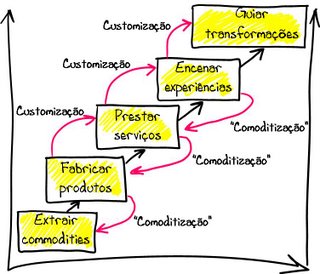"In service businesses, increased productivity does not always translate into higher profits."Ui, isto vai contra tudo!
.
Então não devemos aumentar a produtividade de um serviço? Claro que devemos, o autor é mais um encalhado no mundo da tríade. Reparem neste trecho:
"Many contemporary businesses are on a quest for productivity gains. They seek to maintain quality and quantity of output at ever-decreasing cost, yielding higher profitability. As advanced economies move more into the service sector, that means many managers devote a lot of attention to designing automated processes that reduce the need for people — typically their most expensive resource."Qual é o erro-base desta análise?
.
.
.
A manutenção do output!
.
Se o output é o mesmo, se não se pode aumentar o preço de algo que se mantém constante ao longo do tempo, para aumentar o lucro temos de aumentar o ritmo da produção, temos de reduzir custos, temos de aumentar a eficiência. Essa é a única forma de aumentar a produtividade, quando se depende desse modelo mental. Acabo de passar por uma loja "Grab & Go" em Soares dos Reis-Gaia, esse é o destino, a commoditização total.
.
Qual é a alternativa?
Quem presta serviços, para fugir à commoditização, tem de saltar para as experiências. Tem de oferecer uma oferta diferente com mais valor acrescentado potencial.
.
A falha do modelo mental do autor do artigo é desmontado aqui.
.
Um artigo destes na revista do MIT só ilustra como estes modelos mentais estão impregnados nas escolas... professores que continuam a moldar e enformar alunos no modelo económico do século XX.






























